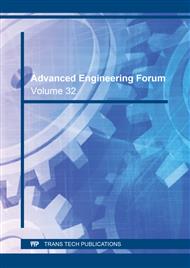[1]
S. Moaveni. Finite element analysis: Theory and Application with Ansys. Prentice Hall, Upper Saddle River, (1999).
Google Scholar
[2]
G. Creci et al. Rotordynamic Analysis of a 5-Kilonewton Thrust Gas Turbine by Considering Bearing Dynamics. Journal of Propulsion and Power, v. 27, n. 2, pp.330-336, (2011).
DOI: 10.2514/1.b34104
Google Scholar
[3]
G. Creci Filho. Influência da dinâmica dos mancais na resposta vibratória de uma turbina aeronáutica de 5-KN de empuxo. São José dos Campos: ITA, 2012. 307p. Tese (Doutorado).
DOI: 10.24849/j.geot.2019..145.03
Google Scholar
[4]
G. Creci et al. Influence of the Radial Clearance of a Squeeze Film Damper on the Vibratory Behavior of a Single Spool Gas Turbine Designed for Unmanned Aerial Vehicle Applications. Shock and Vibration, v. 2017, pp.1-13, (2017).
DOI: 10.1155/2017/4312943
Google Scholar
[5]
N.S. Vyas, Sidharth and J.S. Rao. Dynamic stress analysis and a fracture mechanics approach to life prediction of turbine blades. Mechanism and Machine Theory, v. 32, n. 4, pp.511-527, (1997).
DOI: 10.1016/s0094-114x(96)00067-5
Google Scholar
[6]
R.A. Cláudio et al. Fatigue life prediction and failure analysis of a gas turbine disc using the finite‐element method. Fatigue & Fracture of Engineering Materials & Structures, v. 27, n. 9, pp.849-860, (2004).
DOI: 10.1111/j.1460-2695.2004.00810.x
Google Scholar
[7]
Z. Mazur et al. Failure analysis of a gas turbine blade made of Inconel 738LC alloy. Engineering Failure Analysis, v. 12, n. 3, pp.474-486, (2005).
DOI: 10.1016/j.engfailanal.2004.10.002
Google Scholar
[8]
E. Poursaeidi, M. Aieneravaie and M.R. Mohammadi. Failure analysis of a second stage blade in a gas turbine engine. Engineering Failure Analysis, v. 15, n. 8, pp.1111-1129, (2008).
DOI: 10.1016/j.engfailanal.2007.11.020
Google Scholar
[9]
D. Brujic et al. CAD based shape optimization for gas turbine component design. Structural and Multidisciplinary Optimization, v. 41, n. 4, pp.647-659, (2010).
DOI: 10.1007/s00158-009-0442-9
Google Scholar
[10]
K. Kumar, S.L. Ajit Prasad and Shivarudraiah. Strength evaluation in turbo machinery blade disk assembly at constant speed. International Journal of Automotive and Mechanical Engineering, v. 2, pp.119-129, (2010).
DOI: 10.15282/ijame.2.2010.2.0010
Google Scholar
[11]
T. Sadowski and P. Golewski. Multidisciplinary analysis of the operational temperature increase of turbine blades in combustion engines by application of the ceramic thermal barrier coatings (TBC). Computational Materials Science, v. 50, n. 4, pp.1326-1335, (2011).
DOI: 10.1016/j.commatsci.2010.05.032
Google Scholar
[12]
K.M. Kim et al. Analysis of conjugated heat transfer, stress and failure in a gas turbine blade with circular cooling passages. Engineering Failure Analysis, v. 18, n. 4, pp.1212-1222, (2011).
DOI: 10.1016/j.engfailanal.2011.03.002
Google Scholar
[13]
E. Poursaeidi et al. Effects of natural frequencies on the failure of R1 compressor blades. Engineering Failure Analysis, v. 25, pp.304-315, (2012).
DOI: 10.1016/j.engfailanal.2012.05.013
Google Scholar
[14]
N.A. Osama et al. Computational Fluid Dynamic Analysis of a Vibrating Turbine Blade. International Journal of Rotating Machinery, v. 2012, pp.1-15, (2012).
Google Scholar
[15]
L.M. Amoo. On the design and structural analysis of jet engine fan blade structures. Progress in Aerospace Sciences, v. 60, pp.1-11, (2013).
DOI: 10.1016/j.paerosci.2012.08.002
Google Scholar
[16]
M.E. Hesham et al. Effect of Secondary Flows on Heat Transfer of a Gas Turbine Blade. International Journal of Rotating Machinery, v. 2013, pp.1-12, (2013).
Google Scholar
[17]
S. Madhavan et al. Vibration based damage detection of rotor blades in a gas turbine engine. Engineering Failure Analysis, v. 46, pp.26-39, (2014).
DOI: 10.1016/j.engfailanal.2014.07.021
Google Scholar
[18]
K. Kim and Y.S. Lee. Modal characteristics and fatigue strength of compressor blades. Journal of Mechanical Science and Technology, v. 28, n. 4, pp.1421-1429, (2014).
DOI: 10.1007/s12206-014-0129-z
Google Scholar
[19]
S. Beretta et al. Structural integrity assessment of turbine discs in presence of potential defects: probabilistic analysis and implementation. Fatigue & Fracture of Engineering Materials & Structures, v. 38, n. 9, pp.1042-1055, (2015).
DOI: 10.1111/ffe.12325
Google Scholar
[20]
F. Sun et al. Microstructural evolution and deformation features in gas turbine blades operated in-service. Journal of alloys and compounds, v. 618, pp.728-733, (2015).
DOI: 10.1016/j.jallcom.2014.08.246
Google Scholar
[21]
F. Vakili-Tahami and M.R. Adibeig. Investigating the possibility of replacing In738LC gas turbine blades with In718. Journal of Mechanical Science and Technology, v. 29, n. 10, pp.4167-4178, (2015).
DOI: 10.1007/s12206-015-0911-6
Google Scholar
[22]
V.N. Shlyannikov, A.P. Zakharov and R.R. Yarullin. Structural integrity assessment of turbine disk on a plastic stress intensity factor basis. Int. Journal of Fatigue, v. 92, pp.234-245, (2016).
DOI: 10.1016/j.ijfatigue.2016.07.016
Google Scholar
[23]
O.C. Zienkiewicz. The Finite Element Method. McGraw-Hill Company. London. (1977).
Google Scholar
[24]
Slamecka et al. Fatigue life of cast Inconel 713LC with/without protective diffusion coating under bending, torsion and their combination. Science Direct, v. 110, pp.459-467, (2013).
DOI: 10.1016/j.engfracmech.2013.01.001
Google Scholar
[25]
W. Wallace, R.T. Holt and E.P. Whelan. Properties of 713lc compacts, hot isostatically pressed at supersolidus temperatures. ASTM, v. 3, n. 2, pp.113-120, (1975).
DOI: 10.1520/jte10145j
Google Scholar


